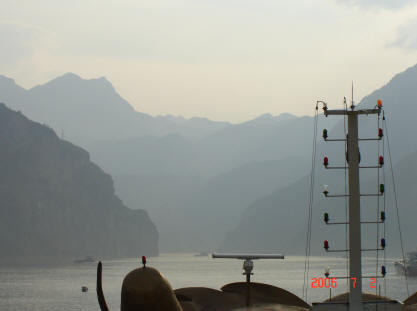
Looking off the Bow of the Dragon Boat - Entering the Gorges

Looking off the Bow of the Dragon Boat - Entering the
Gorges
Stop 4 - The Three Gorges of the Yangtze River "Rapids to Reservoir"
Focus
Question: How have the Chinese
used the Yangtze River throughout their history?
Portfolio Questions:
Why do people live and move where they do? & How has the quest for resources
affected human history?
 Google Earth map of the Yangtze River Three Gorges area. You can see the folds
of mountains that the river flows through.
Google Earth map of the Yangtze River Three Gorges area. You can see the folds
of mountains that the river flows through.
Geography:
The Yangtze River cuts through three mountainous areas
known as "Gorges". The three are named Xiling, Wuxia, and Qutang. Below is a map
of the three gorges:
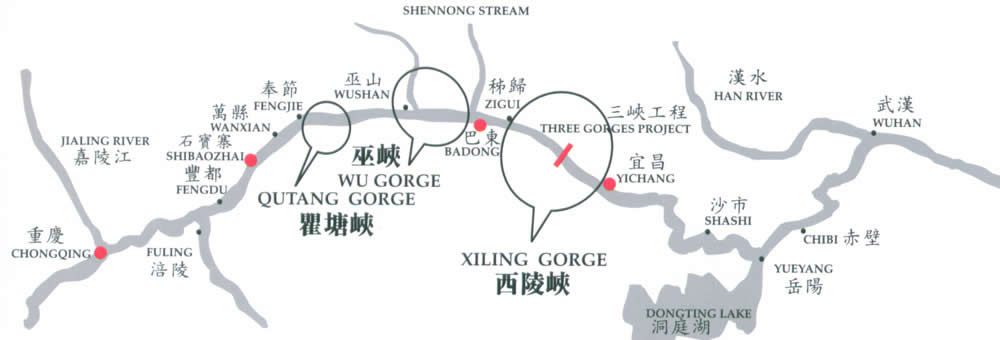
Traveling up the Yangtze River (From right to left on the above map):
Xiling Gorge
- It runs for 66 km. Noted for numerous dangerous sections, with fast flowing
currents. There is a broad valley in the middle which splits the gorge into two
sections.
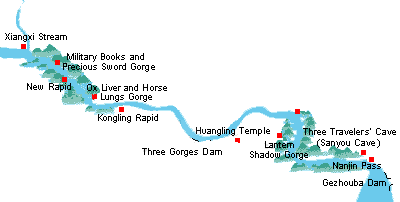 Map of the
Xiling Gorge
Map of the
Xiling Gorge
 Xiling Gorge Pic
Xiling Gorge Pic
Wuxia Gorge
- It's around 45 kilometres long. Also called the Great Gorge, and follows a
zig-zagging course. As with the Qutang gorge, scenic landmarks have already been
submerged by the rising waters.
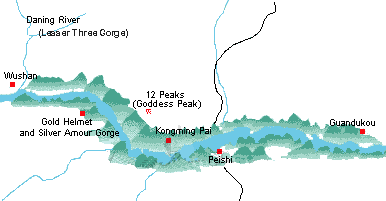 Map of the
Wuxia Gorge
Map of the
Wuxia Gorge
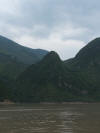 Wuxia Gorge Pic
Wuxia Gorge Pic
Qutang Gorge
- It runs for 66 kilometres. Noted for numerous dangerous sections, with fast
flowing currents. There is a broad valley in the middle which splits the gorge
into two sections.
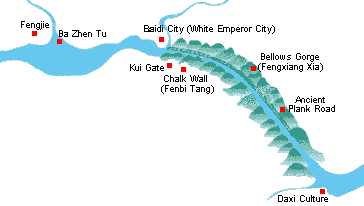 Map of the
Qutang Gorge
Map of the
Qutang Gorge
 Qutang Gorge Pic
Qutang Gorge Pic
History: The Yangtze River has been used for transporting goods for trade for much of Chinese history. Prior to the Three Gorges Dam, the river was known for its rapids and fast running waters, making water travel very difficult and dangerous. Since the water level has been elevated greatly by the Three Gorges Dam, thereby creating a large reservoir (lake) within the gorges, travel has been made much easier than the past. The rapids are now gone and large container ships carrying coal can move up and down the river to and from Chongqing to the East China Sea and out to any port in the world.
Before the Three Gorges Dam:
![]() Without motor boats, Chinese junks (ships) depended upon
"trackers" to pull boats up the Yangtze River rapids from the shoreline.
Without motor boats, Chinese junks (ships) depended upon
"trackers" to pull boats up the Yangtze River rapids from the shoreline.
![]() A junk in the rapids of the Yangtze River.
A junk in the rapids of the Yangtze River.
![]() The trackers had to pull the boats from the rocky
shoreline, making it a dangerous and difficult task.
The trackers had to pull the boats from the rocky
shoreline, making it a dangerous and difficult task.
![]() Many times, boats were wrecked on the rocks in the river
or on its shores.
Many times, boats were wrecked on the rocks in the river
or on its shores.
After the Three Gorges Dam:
 Deeper Waters - What was once rapids is now calm, deep, and easy to
travel through.
Deeper Waters - What was once rapids is now calm, deep, and easy to
travel through.
![]() Trackers for Tourism - Now, the only trackers work for tourists, pulling them up
rapids in the tributaries of the Yangtze in smaller boats.
Trackers for Tourism - Now, the only trackers work for tourists, pulling them up
rapids in the tributaries of the Yangtze in smaller boats.
![]() Trackers Up Close - Here's a close up of the tourist trackers. Imagine dozens
more pulling the junks up the Yangtze.
Trackers Up Close - Here's a close up of the tourist trackers. Imagine dozens
more pulling the junks up the Yangtze.
 The Coal Industry - Here is a coal loading station on the banks of the
Yangtze River. Barges pull up to these areas and coal is loaded onboard. The
coal is initially transported from mines by truck and dumped in these container
areas.
The Coal Industry - Here is a coal loading station on the banks of the
Yangtze River. Barges pull up to these areas and coal is loaded onboard. The
coal is initially transported from mines by truck and dumped in these container
areas.
 Transporting Coal - Here's a coal barge carrying
its load down river. The Chinese rely on coal to produce over 3/4 of their energy. Much of the river
traffic consists of these ships. The Three Gorges Dam has made it easy to
transport coal by river. The Three Gorges Dam provides clean energy versus the
highly polluting coal burning plants.
Transporting Coal - Here's a coal barge carrying
its load down river. The Chinese rely on coal to produce over 3/4 of their energy. Much of the river
traffic consists of these ships. The Three Gorges Dam has made it easy to
transport coal by river. The Three Gorges Dam provides clean energy versus the
highly polluting coal burning plants.
 Increased Trade - "Cargo transportation via the
Three Gorges Dam increased to 44 million tons last year from 14.75 million tons
in 2003." (Article)
Cargo ships like this one are a common site and will only increase in volume
with time. Below is an example of the trade in automobiles down the
Yangtze River to the port in Shanghai. It's the largest container port in the
world!
Increased Trade - "Cargo transportation via the
Three Gorges Dam increased to 44 million tons last year from 14.75 million tons
in 2003." (Article)
Cargo ships like this one are a common site and will only increase in volume
with time. Below is an example of the trade in automobiles down the
Yangtze River to the port in Shanghai. It's the largest container port in the
world!
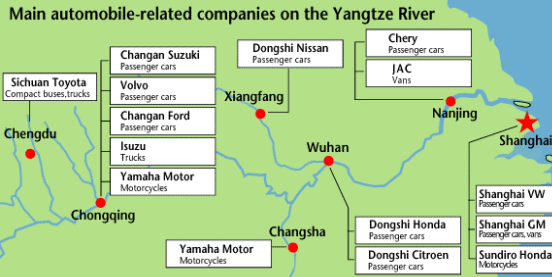 |
|
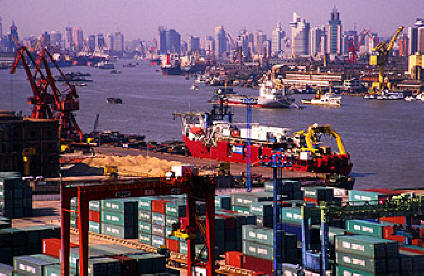 |
Photo
Galleries:
Three Gorges Geography
Three Gorges
Infrastructure
Three Gorges Life
Three Gorges River Traffic
Shennong Gorge (Tributary of Yangtze) and Trackers
Article:
The Shennong River
Trackers: A Vanishing Way of Life
Websites for More Information:
BBC News:
A Coal Dependent Future?
(Includes great video clip)
PowerPoint:
Then & Now on the Yangtze River
(Includes the Elliot Slides)
Back to Yangtze River Web Tour Main Page